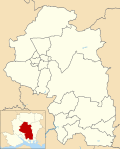| Curdridge | |
|---|---|
 Curdridge Church | |
Location within Hampshire | |
| Population | 1,398 (2011) [1] |
| OS grid reference | SU5277113792 |
| Civil parish |
|
| District | |
| Shire county | |
| Region | |
| Country | England |
| Sovereign state | United Kingdom |
| Post town | SOUTHAMPTON |
| Postcode district | SO32 |
| Dialling code | 01489 |
| Police | Hampshire and Isle of Wight |
| Fire | Hampshire and Isle of Wight |
| Ambulance | South Central |
| UK Parliament | |
Curdridge is a village and civil parish within the City of Winchester district of Hampshire, England. The parish also contains the similarly named village of Curbridge. The village has a small school. [2] The parish is located eight miles to the east of Southampton [2] and had a population of 1,292 people in 473 households in the 2001 census, [3] the population increasing to 1,398 in 520 households at the 2011 Census. [1] Curdridge is also known for its annual Curdridge Country Show that takes place in a field off Reading Room Lane [4]
Contents
Although named after the nearby village of Botley, Botley railway station is actually located in the civil parish of Curdridge. [5]



